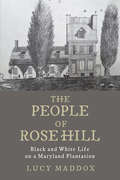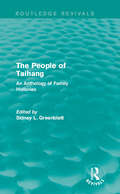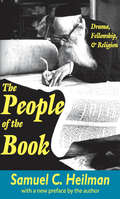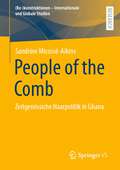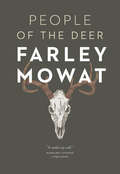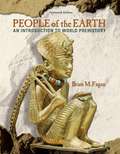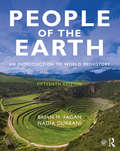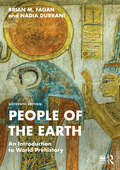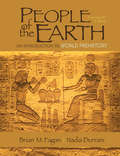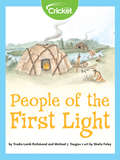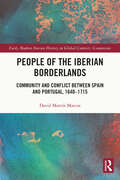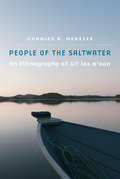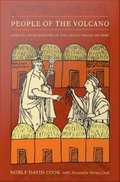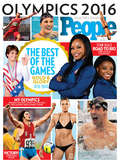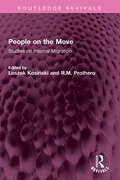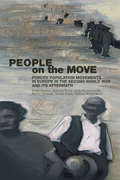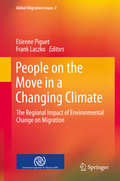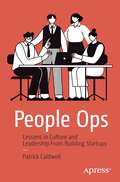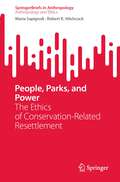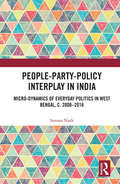- Table View
- List View
The People of Rose Hill: Black and White Life on a Maryland Plantation
by Lucy MaddoxWhat was antebellum life like for the two communities of people—one white and one black—who lived and worked on a plantation on the Eastern Shore of Maryland?Thomas Marsh Forman was in his early twenties when he returned from the Revolutionary War to take over the proprietorship of Rose Hill plantation from his father. The estate lay alongside the Sassafras River in Cecil County, on Maryland's Eastern Shore. Rose Hill was a product of its historical moment, a moment in which men like Forman acted on their belief that the future prospects of the country required a continuation not only of their energy, their skills, and their desire to improve the lives of Americans but also of the slave economy they had done so much to shape. A focused study of this one plantation, The People of Rose Hill illuminates the workings of the entire plantation system in the border region between the end of the Revolution and the approach of the Civil War. Lucy Maddox looks closely at the public and private lives of the people of Rose Hill, who labored together in a profitable agricultural enterprise while maintaining relationships with one another that were cautious, distant, sometimes secretive, and often explosive. Making extensive use of the letters of wife, Martha Ogle Forman, Maddox places the experiences of Rose Hill's inhabitants (enslaved and free) within the context of the cultural, economic, and political history of the state. Piecing together the scattered information in these documents, she offers readers fascinating insights into life and labor on the plantation, from grueling daily work schedules to menus for elaborate dinners and teas. Her account includes comparative analyses of family structures and social practices within the Forman family and in the community of enslaved workers. Individual sections profile thirty-eight of the fifty enslaved people at Rose Hill, identifying, as far as possible, that person's primary work responsibilities, family connections, and history at the plantation, thus giving each a recognized place in the larger history of plantation slavery in the Upper South. Maddox's discussion of Rose Hill extends to the places around it where the slave culture of the plantation found confirmation and support: churches, law courts, social gatherings, agricultural fairs and societies, the parlors and sitting rooms of the Eastern Shore elite. The People of Rose Hill is a fascinating look at the intersection of the constricted world of the plantation with the larger world of early America.
People of Substance
by Carlos Londono-SulkinPeople of Substance is a lively, accessible ethnography of a complex indigenous group of people of the Colombian Amazon who call themselves 'People of the Center. ' Carlos David Londoño Sulkin examines this group's understandings and practices relating to selfhood, social organization, livelihood, and symbolism. Through this, he makes a strong case for increased anthropological attention to morality and ethics.Londoño Sulkin explains a number of key issues and debates in Amazonian anthropology with great clarity, making People of Substance a useful text for students. At the same time, it is theoretically sophisticated, combining innovative research methods with sound analysis of empirically gathered material. Contributing both to accounts of regional history and to discussions on anthropology and history, People of Substance offers valuable engagement with concepts of structure, agency, and freedom.
The People of Taihang: An Anthology of Family Histories (Routledge Revivals)
by Sidney L. GreenblattThe Taihang Mountains lay on the border between Shansi and Hopei in China and originally published in 1972, this edited anthology collates family histories as told by the people who lived there. These accounts are a small sample of the family histories that made up the Taihang community taken from poor or lower-middle peasants to discuss the hardships they faced in the early twentieth century and to provide insight into a rural life to a new generation of Chinese youths. This title will be of interest to students of Asian studies and Anthropology.
The People of the Book: Drama, Fellowship and Religion
by Samuel C. HeilmanJudaism has long derived its identity from its sacred books. The book or scroll--rather than the image or idol--has been emblematic of Jewish faith and tradition. The People of the Book presents a study of a group of Orthodox Jews, all of whom live in the modern world, engaged in the time-honored practice of lernen, the repeated review and ritualized study of the sacred texts. In preserving one of the activities of Jewish life, Samuel C. Heilman argues, these are the genuine -People of the Book.- For two years, Heilman participated in and observed five study circles in New York and Jerusalem engaged in the avocation of lernen the Talmud, the great corpus of Jewish law, lore, and tradition. These groups, made up of men who felt the ritualized study of sacred texts to be not only a religious obligation but also an appealing way to spend their evenings, weekends, and holidays, assembled together under the guidance of a teacher to review the holy books of their people. Having become part of this world, the author is able to provide first-hand observation of the workings of the study circle. Heilman's study moves beyond the merely descriptive into an analysis of the nature and meaning of activity he observed. To explain the character and appeal of the study groups, he employs three concepts: drama, fellowship, and religion. Inherent to the life of the study circle are various sorts of drama: -social dramas- playing out social relationships, -cultural performances- reenacting the Jewish world view, and -interactional dramas- and -word plays- involving the intricacies of the recitation and translation process. This book will be of interest to anthropologists and those interested in the academic study of religion.
People of the Comb: Zeitgenössiche Haarpolitik in Ghana ((Re-)konstruktionen - Internationale und Globale Studien)
by Sandrine Micossé-Aikins"Afrika" dient in vielen haarpolitischen Debatten nur als positive und teilweise sehr unpräzise definierte Projektionsfläche, die für eine bessere vorkoloniale Schwarze Welt steht. Nur wenig Aufmerksamkeit wurde bisher darauf verwendet, die tatsächlich gegenwärtig gelebte Haarkultur- und -politik in verschiedenen kontinentalafrikanischen Kontexten auch auf ihr Eingebettet-Sein in globale, historisch gewachsene Hierarchien hin zu betrachten. Oft wird übersehen, dass auch hier – auf ihre eigene Weise – rassistische Ideologien und insbesondere weiße Vorherrschaft als koloniale Kontinuitäten wirken, und zeitgenössische Haarkultur mitprägen. Die vorliegende Arbeit möchte einen Beitrag dazu leisten, diese Dynamiken besser zu verstehen. Dabei werden jedoch auch relevante Facetten Schwarzen Selbstverständnisses und gelebte ästhetische Praktiken beleuchtet, die über die Auseinandersetzung mit weißer Vorherrschaft hinausweisen.
People of the Deer
by Farley MowatIn 1886, the Ihalmiut of northern Canada numbered 7,000 souls; by 1946, when 25-year-old Farley Mowat travelled to the Arctic, their population had dwindled to only 40. Living among them, he observed the millennia-old migration of the caribou and endured the bleak winters, food shortages and continual, devastating intrusions of interlopers bent on exploiting the Arctic. In this seminal book, Mowat details a genocide wrought by misunderstanding and neglect. Debated long after its publication, this powerful story of the Ihalmiut continues to haunt the Canadian conscience.
People of the Earth: An Introduction to World Prehistory
by Brian M. FaganThis internationally renowned textbook provides the only truly global account of human prehistory from the earliest times through the earliest civilizations. Written in an accessible way, People of the Earth shows how today's diverse humanity developed biologically and culturally over millions of years against a background of constant climatic change.
People of the Earth: An Introduction to World Prehistory
by Brian M. Fagan Nadia DurraniPeople of the Earth is a narrative account of the prehistory of humankind from our origins over 3 million years ago to the first pre-industrial civilizations, beginning about 5,000 years ago. This is a global prehistory, which covers prehistoric times in every corner of the world, in a jargon-free style for newcomers to archaeology. Many world histories begin with the first civilizations. This book starts at the beginning of human history and summarizes the latest research into such major topics as human origins, the emergence and spread of modern humans, the first farming, and the origins of civilization. People of the Earth is unique in its even balance of the human past, its readily accessible style, and its flowing narrative that carries the reader through the long sweep of our past. The book is highly illustrated, and features boxes and sidebars describing key dating methods and important archaeological sites. This classic world prehistory sets the standard for books on the subject and is the most widely used prehistory textbook in the world. It is aimed at introductory students in archaeology and anthropology taking survey courses on the prehistoric past, as well as more advanced readers. It will also appeal to students of human responses to climatic and environmental change.
People of the Earth: An Introduction to World Prehistory
by Brian M. Fagan Nadia DurraniPeople of the Earth is a narrative account of the prehistory of humankind from our origins over 6 million years ago to the first pre-industrial states, beginning about 5,000 years ago. This is a global prehistory, which covers prehistoric times in every corner of the world in a jargon-free style for newcomers to archaeology. Many world histories begin with the first pre-industrial states. This book starts at the beginning of human history and summarizes the latest research into such major topics as human origins, the emergence and spread of modern humans, the first farming, and the origins of civilization. People of the Earth is unique in its even balance of the human past, its readily accessible style, and its flowing narrative that carries the reader through the long sweep of our past. The book is highly illustrated and features boxes and sidebars describing key dating methods and important archaeological sites. This classic world prehistory sets the standard for books on the subject and is the most widely used such textbook in the world. It is aimed at introductory students in archaeology and anthropology taking survey courses on the prehistoric past, as well as more advanced readers. It will also appeal to students of human responses to climatic and environmental change.
People of the Earth: An Introduction to World Prehistory
by Dr Brian Fagan Nadia DurraniUnderstand major developments of human prehistory People of the Earth: An Introduction to World Prehistory 14/e, provides an exciting journey though the 7-million-year-old panorama of humankind's past. This internationally renowned text provides the only truly global account of human prehistory from the earliest times through the earliest civilizations. Written in an accessible way for beginning students, People of the Earth shows how today's diverse humanity developed biologically and culturally over millions of years against a background of constant climatic change.
People of the First Light
by Trudie Lamb RichmondThe Wampanoags, who inhabited what it is now southeastern Massachusetts, were strikingly different from the Pilgrims, who did not share the same interests in sharing land. The native people could not foresee Europeans taking the land that the Wampanoags had once respected and treasured.
People of the Iberian Borderlands: Community and Conflict between Spain and Portugal, 1640–1715 (Early Modern Iberian History in Global Contexts)
by David Martín MarcosThis book is devoted to the inhabitants of the Spanish–Portuguese borderlands during the early modern period. It seeks to challenge a predominant historiography focused on the study of borderlands societies, relying exclusively on the antagonistic topics of subversion and the construction of boundaries. It states that by focusing just on one concept or another there is a restrictive understanding tending to condition the agency of local communities by external narratives. Thus, if traditionally border people were reduced by some scholars to actors of a struggle against a supposedly imposed border; in a more modern perspective, their behaviors have been also framed in bottom-up processes of consolidation of spaces of sovereignty in a no less limiting vision. Faced with both approaches, the objective of this work is not to deny them but, first and foremost, to situate the experiences of border populations outside of logics that I understand as originally alien to themselves, and to highlight their own subjectivity. Finally, it also demonstrates that most of the practices developed by border people were fundamentally aimed at defending their local communities. It will be useful for both audiences interested in early modern Iberia or border studies from a bottom-up perspective.
People of the Iberian Borderlands: Community and Conflict between Spain and Portugal, 1640–1715 (Early Modern Iberian History in Global Contexts)
by David Martín MarcosThis book is devoted to the inhabitants of the Spanish–Portuguese borderlands during the early modern period. It seeks to challenge a predominant historiography focused on the study of borderlands societies, relying exclusively on the antagonistic topics of subversion and the construction of boundaries. It states that by focusing just on one concept or another there is a restrictive understanding tending to condition the agency of local communities by external narratives. Thus, if traditionally border people were reduced by some scholars to actors of a struggle against a supposedly imposed border; in a more modern perspective, their behaviors have been also framed in bottom-up processes of consolidation of spaces of sovereignty in a no less limiting vision. Faced with both approaches, the objective of this work is not to deny them but, first and foremost, to situate the experiences of border populations outside of logics that I understand as originally alien to themselves, and to highlight their own subjectivity. Finally, it also demonstrates that most of the practices developed by border people were fundamentally aimed at defending their local communities.It will be useful for both audiences interested in early modern Iberia or border studies from a bottom-up perspective.
People of the Lake: Mankind and its Beginnings
by Richard E. Leakey Roger LewinIn the crocodile-infested waters near Lake Turkana in Kenya, Leaky is piecing together the clues of an ancient puzzle, reconstructing the world of our primeval forefathers in eerie detail.
People of the Saltwater: An Ethnography of Git lax m'oon
by Charles R. MenziesA 2017 Choice Outstanding Academic Title In People of the Saltwater, Charles R. Menzies explores the history of an ancient Tsimshian community, focusing on the people and their enduring place in the modern world. The Gitxaała Nation has called the rugged north coast of British Columbia home for millennia, proudly maintaining its territory and traditional way of life.People of the Saltwater first outlines the social and political relations that constitute Gitxaała society. Although these traditionalist relations have undergone change, they have endured through colonialism and the emergence of the industrial capitalist economy. It is of fundamental importance to this society to link its past to its present in all spheres of life, from its understanding of its hereditary leaders to the continuance of its ancient ceremonies. Menzies then turns to a discussion of an economy based on natural-resource extraction by examining fisheries and their central importance to the Gitxaałas’ cultural roots. Not only do these fisheries support the Gitxaała Nation economically, they also serve as a source of distinct cultural identity. Menzies’s firsthand account describes the group’s place within cultural anthropology and the importance of its lifeways, traditions, and histories in nontraditional society today.
People of the Volcano: Andean Counterpoint in the Colca Valley of Peru
by Noble David Cook Alexandra Parma CookWhile it now attracts many tourists, the Colca Valley of Peru's southern Andes was largely isolated from the outside world until the 1970s, when a passable road was built linking the valley--and its colonial churches, terraced hillsides, and deep canyon--to the city of Arequipa and its airport, eight hours away. Noble David Cook and his co-researcher Alexandra Parma Cook have been studying the Colca Valley since 1974, and this detailed ethnohistory reflects their decades-long engagement with the valley, its history, and its people. Drawing on unusually rich surviving documentary evidence, they explore the cultural transformations experienced by the first three generations of Indians and Europeans in the region following the Spanish conquest of the Incas. Social structures, the domestic export and economies, and spiritual spheres within native Andean communities are key elements of analysis. Also highlighted is the persistence of duality in the Andean world: perceived dichotomies such as those between the coast and the highlands, Europeans and Indo-Peruvians. Even before the conquest, the Cabana and Collagua communities sharing the Colca Valley were divided according to kinship and location. The Incas, and then the Spanish, capitalized on these divisions, incorporating them into their state structure in order to administer the area more effectively, but Colca Valley peoples resisted total assimilation into either. Colca Valley communities have shown a remarkable tenacity in retaining their social, economic, and cultural practices while accommodating various assimilationist efforts over the centuries. Today's population maintains similarities with their ancestors of more than five hundred years ago--in language, agricultural practices, daily rituals, familial relationships, and practices of reciprocity. They also retain links to ecological phenomena, including the volcanoes from which they believe they emerged and continue to venerate.
PEOPLE Olympics 2016: Gold and Glory
by The Editors of PEOPLELet the games begin! From Berlin to Barcelona, Beijing to Brazil, the Olympics celebrate the dedication, perseverance, drive and talent of athletes around the world. Whether it's swimming, gymnastics, basketball, volleyball, rowing or archery, all sports fans fall in love with the electric spirit of the Games that unites cultures and countries around the world every four years.PEOPLE Olympics 2016: The Best of the Games brings you inside the Olympics, both past and present: Featuring profiles of familiar faces such as 22-time Olympic medalist Michael Phelps and 2-time Olympic medalist Gabby Douglas as well as introducing the new wave of talent such as gymnast Simone Biles and track star English Gardner, The Best of the Games chronicles the best of the best over the years. Complete with beautiful, full-color photography, this special edition invites you to relive some of the most memorable Olympic moments - Muhammad Ali's torch lighting at the Atlanta Olympics in 1996, the US Women's Soccer Olympic title in the first-ever Women's Soccer Olympic competition, and Michael Johnston's golden finish, just to name a few. From their pre-Olympics path to the podium to post-Olympics life, The Best of the Games showcases the inspiring passion of athletes around the world and how they gave everything for the love of their fans, family, country, and above all: their sport.
People on the Move: Studies on Internal Migration (Routledge Revivals)
by Leszek A. Kosinski R. Mansell ProtheroOriginally published in 1975, this volume examines conceptual and theoretical aspects of the study of internal migration, both in chapters dealing specifically with theory and data and in case studies. The book discusses the question of who migrates, and why and what are the patterns of flow and direction of movement. The consequences of migration are analysed. Migration is one of the most difficult components of population change to conceptualize and measure and this book considers a wide range of aspects of migration and the problems connected with it.
People on the Move: Forced Population Movements in Europe in the Second World War and its Aftermath
by Pertti Ahonen; Gustavo Corni; Jerzy Kochanowski; Rainer Schulze; Tamás Stark; Barbara Stelzl-MarxEurope has a long history of state-led population displacement on ethnic grounds. The nationalist argument of ethnic homogeneity has been a crucial factor in the mapping of the continent. At no time has this been more the case than during and after the Second World War. Both under the aggressive expansionism of the Third Reich and after Germany's defeat, millions were brutally forced out of their homelands. Presenting a history from the top as well as the bottom, People on the Move reconstructs the complex map of forced population displacements that took place across Europe during and immediately after the Second World War.
People on the Move in a Changing Climate
by Etienne Piguet Frank LaczkoPolicymakers around the world are increasingly concerned about the likely impact of climate change and environmental degradation on the movement of people. This book takes a hard look at the existing evidence available to policymakers in different regions of the world. How much do we really know about the impact of environmental change on migration? How will different regions of the world be affected in the future? Is there evidence to show that migration can help countries adapt to environmental change ? What types of research have been conducted, how reliable is the evidence? These are some of the questions considered in this book, which presents, for the first time, a synthesis of relevant research findings for each major region of the world. Written by regional experts, the book provides a comprehensive overview of the key findings of existing studies on the linkages between environmental change and the movement of people. More and more reports on migration and the environment are being published, but the information is often scattered between countries and within regions, and it is not always clear how much of this information is based on solid research. This book brings this evidence together for the first time, highlighting innovative studies and research gaps. In doing this, the book seeks to help decision-makers draw lessons from existing studies and to identify priorities for further research.
People Ops: Lessons in Culture and Leadership From Building Startups
by Patrick CaldwellLearn how to deal with difficult employee demands, what candidates actually think about recruitment processes, how to navigate layoffs, address the gender pay gap, and protect your time and wellbeing. People Ops is a collection of candid lessons, stories, and principles in leadership, people, and culture from startup environments. It reveals the hard truths and sometimes uncomfortable realities that we all know exist but struggle to articulate.For decades, business and HR leaders have struggled to navigate the complexities of managing people and teams within startups and scaling companies, instead relying on the broad rhetoric of management theory to tackle these challenges or leaning on their networks of leaders who have encountered these challenges before. In parallel, the HR industry has been undergoing a transformation with the growth of People Operations. It’s a distinct field in HR that relentlessly focuses on engagement, culture, automation and putting people at the heart of all business operations. At the intersection of startups and people operations is an increasingly ambiguous business challenge for how startups can apply leading people practices to drive their growth, rather than in spite of their growth.People Ops is a tactical companion for business and People Operations leaders designed to support them in their roles, spark inspiration and challenge conventional thinking. It supplements author Patrick Caldwell's own experience across multiple startups with stories and examples from his network of investors, CEOs, Founders and C-Level HR executives.What You'll LearnLessons from a path walked building People Operations in a startup environmentUncomfortable truths around the complexities of managing people The key components of a People Operations strategy within a small businessWho This Book is ForThose in small-medium sized businesses, especially startups, where the reader is in a position of responsibility for people and culture. They’ll likely hold business leadership positions such as Founder, CEO, COO, VP and Director, or they’ll be directly within the HR and People Operations space with titles such as CHRO/CPO, Head, Director, Business Partner or Advisor
People, Parks, and Power: The Ethics of Conservation-Related Resettlement (SpringerBriefs in Anthropology)
by Maria Sapignoli Robert K. HitchcockThis book presents a critical review of the ethics of conservation-related resettlement. We examine what has become known as the” parks versus people” debate, also known as the “new conservation debate,” which has pitted indigenous and other local people against nation states and social scientists against ecologists and conservationists for the past several decades. Aiming to promote biodiversity conservation and habitat preservation, some biologists, park planners, and conservation organizations have recommended that indigenous and other people should be removed from protected areas. Local people, for their part, have argued that residents of the areas that were turned into protected areas, national parks, game reserves and monuments had managed them in productive ways for generations and that they should have the right to remain there and to use natural resources as long as they do so sustainably. This position is often supported by indigenous rights organizations and social scientists, especially anthropologists. There are also some conservation-oriented NGOs that have policies involving a more human rights-oriented approach aimed at poverty alleviation, sustainable development, and social justice. The book discusses biodiversity conservation, indigenous peoples (those who are ethnic minorities and who are often marginalized politically), and protected areas, those categories of land set aside by nation-states that have various kinds of rules about land use and residence. The focus initially is on case studies from protected areas in the United States including Yellowstone National Park, Yosemite National Park, and Glacier National Park and on national monuments and historical parks where resettlement took place. We then consider issues of coercive conservation in southern Africa, including Hwange National Park (Zimbabwe), the Central Kalahari Game Reserve (Botswana), Etosha National Park, and Bwabwata National Park (Namibia), and Kgalagadi Transfrontier Park (South Africa and Botswana). All of these cases involved involuntary resettlement at the hands of the governments. In the book we consider some of the social impacts of conservation-forced resettlement (CfR), many of which tend to be negative. After that, we assess some of the strategies employed by indigenous peoples in their efforts to recover rights of access to protected areas and the cultural and natural resources that they contain. Examples are drawn from cases in Asia, Africa, and South America. Conclusions are provided regarding the ethics of conservation-related resettlement and some of the best practices that could be followed, particularly with regard to indigenous peoples.
People-Party-Policy Interplay in India: Micro-dynamics of Everyday Politics in West Bengal, c. 2008 – 2016
by Suman NathThis book analyses the political transition in West Bengal, India, which witnessed longest democratically elected Left regime of the world. It examines and compares micro-dynamics of political practices in India and delineates underlying political themes of state politics. The author explores the politics of land reform and the anti-land-acquisition movements which were critical points in the contemporary history of Bengal in independent India. The volume further delves into the caste and communal politics which had been latent until the Left Front’s loss in the state, as well as the what sets apart politics in West Bengal from other Indian states. Based on thorough ethnographic research, this volume will be of great interest to scholars and researchers of South Asian studies, politics and political processes, sociology and social anthropology.
